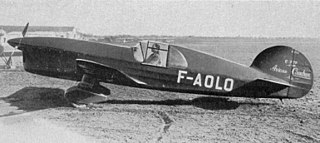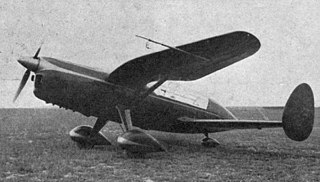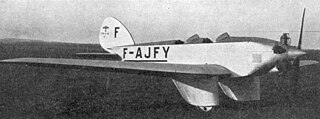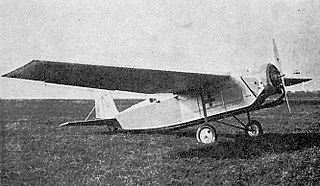Related Research Articles

The C.710 were a series of light fighter aircraft developed by Caudron-Renault for the French Air Force just prior to the start of World War II. One version, the C.714, saw limited production, and were assigned to Polish pilots flying in France after the fall of Poland in 1939. A small number was also supplied to Finland.
The Latécoère 14 and Latécoère 16 were similar French passenger and postal aircraft of advanced design built in 1923. They differed chiefly in engine power. Only one of each was constructed. The 14's type number was reused for an unrelated parasol wing prototype that was basis of the more successful Latécoère 17.

The Caudron C.140 was a French tandem cockpit sesquiplane designed in 1928 as a combination of liaison aircraft and observer and gunnery trainer.

The Albessard Triavion, sometimes known as the Peyret-Albessard Triavion, was a three surface aircraft, combining a tandem wing and conventional tailplane.

The Delanne 20-T was a French tandem wing aircraft designed as an aerodynamic model for a larger fighter aircraft. It was tested during 1939.

The SFCA Lignel 20 was a French, single engine, low wing monoplane, one of a series of this type built by SFCA in the 1930s. It was capable of aerobatics but was primarily a racing aircraft.

The SFCA Lignel 10 was a French single seat aircraft designed to bridge a training gap between basic trainers and front-line fighters. The military requirement was soon dropped and only one was built.

The Albert A-60 was a single engine, two seat, wooden sports monoplane designed and built in France in the early 1930s. Two were built and flown with three different engines.

The Nieuport-Delage NiD 590 was a three engine, high wing monoplane designed for policing and other roles in France's colonies, which did not go into production or enter service.
The Caudron C.580 was a French advanced trainer aircraft intended to prepare pilots for the new low wing monoplane fighters of the mid-1930s. It did not go into production and only two were built.
The Gaucher RG.40 Week-End was a high-wing, two-seat, low-power, touring aircraft built in France in 1935. Three were built and later SECAT produced several rather similar designs, all from designer Rémy Gaucher.
The Duverne-Saran 01 was a twin engine, three seat touring aircraft built in France in the mid-1930s. Only one was completed.

The Morane-Saulnier MS.350 was a French aerobatic trainer flown in 1936. Only one was built but it had a long career, flying post-war until the 1960s.
The Caudron C.860 was a single engine, single seat monoplane ordered by the French government as a long distance communications aircraft. First flown in 1938, it was also expected to set speed and altitude records but the outbreak of World War II ended developments.

The Wibault 260 R.2 was a contender for a French government contract for a long range, two seat reconnaissance aircraft, issued in 1928. There were eight prototypes in the 1931-2 contest and the Wibault was not selected for production.

The Guillemin JG.40 was designed and built to meet a French government requirement for a small air ambulance capable of operating in the colonies. Two were completed and performed well but the JG.40 did not reach production.

The Guillemin JG.10 or Blériot-Guillemin JG.10 was a French two seat touring aircraft, designed to be as simple and safe to fly and maintain as a car, with similar facilities, as well as provision for parachutes.
The Poite 3 was a one-off, all metal touring aircraft which seated two in tandem. It was built and flown in France in 1931.
The Muniz M-5 was the first of Antonio Guedez Muniz's aircraft designs to fly; soon afterwards he became the first Brazilian to design an aircraft which reached series production. The sole example of the M-5, built while he was a student in France by Caudron, was a low wing cabin tourer or military liaison aircraft.

The Lumière-de Monge racer was built specifically to compete in the 1921 Coupe Deutsch de la Meurthe and was flown at Etampes on 1 October 1921. In addition to its speed, it was unusual in being a high wing monoplane which could be rapidly converted into a biplane by adding a smaller lower wing. It crashed before the race, killing its pilot, and was unable to participate.
References
- 1 2 3 4 5 6 Frachet, André (26 March 1936). "L'avion cargo Caudron-Renault "570"". Les Ailes (771): 3.
- ↑ "A Pair of Heavyweights". Flight . XXIX (1420): 284. 12 March 1936.
- ↑ "Sur les terrains d'essais". Les Ailes (754): 3. 28 November 1935.
- ↑ "Sur les terrains d'essais". Les Ailes (839): 10. 15 July 1936.
- ↑ "Les prototypes civils at militaires en fait, lundi, des exhibitions brilliantes". Les Ailes (806): 16. 26 November 1936.
- ↑ "Les avions en essais". Les Ailes (847): 15. 9 September 1937.